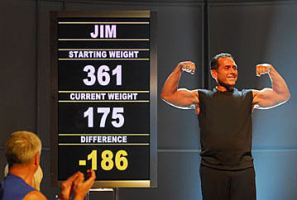NBC’s Biggest Loser’s weight loss methods have been controversial since the show premiered in 2004. Obese contestants passing out, being rushed to the hospital, throwing up and collapsing happens nearly every episode, having many experts and viewers concerned that the workouts are too intense for the morbidly obese participants. Many contestants, after losing upwards of 100 pounds, gain the weight back after leaving the regimented atmosphere of the ranch, leading many to believe that the results are too much too soon, making it impossible to maintain.
A new study, however, shuts the critics right up. Not only do the four to six hour daily workouts help the contestants drop tons of weight fast, but the quality of their weight remains ideal- making the Biggest Loser ranch one of the fastest and most effective ways to lose weight.
Often, when one works out at a high level of intensity, over training is a risk. Over training occurs when the demands on the body are too much, and it rebels, so even when you do the same workout, you will burn less calories and your weight loss will suffer. Another effect of over training is that your body hangs on to body fat to protect itself, and will instead, burn muscle mass, which is the opposite of what you want for optimum health.
Participants on Biggest Loser drop double digit numbers weekly, and with their low calorie diets and all day workouts, they seem like prime candidates for having their muscle burned as fuel when their 1,200-2,000 calories a day are used within the first hour or two of working out. The study, however, says this is not so.
Researchers at the Pennington Biomedical Research Center in Baton Rouge went to the set of the show during Season 8 in 2024. The scientists measured the weight, body composition and resting metabolic rate of the 16 participants at the beginning of the show, during week 6, week 30, and then the finale.
The findings are as follows:
• The contestants dropped from an average 49% body fat to 27%.
• After 30 weeks, participants lost an average of 128 pounds, 81% of which was body fat and 19% of which was lean mass, namely muscle.
This amazing loss of body fat while sparing the muscle “is quite remarkable,” says lead author Darcy Johannsen, assistant professor of skeletal muscle physiology at Pennington. “This means the vigorous exercise helped the contestants preserve their muscle mass, which is the most metabolically active tissue of the body.”
Muscle burns more calories at rest than fat. The more muscle you have on your body, the more calories you burn at rest- this is the true way to increase your metabolism. The goal when losing weight is to lose as much body fat as possible, while sparing muscle mass. Strong muscles and bones are essential to living a long, healthy life.
Senior author Eric Ravussin, director of the Nutrition Obesity Research Center at Pennington, warns that the boot-camp style workouts of Biggest Loser aren’t for everyone, especially the obese. While it gets results, most morbidly obese people are too deconditioned to safely push their bodies to match the weight loss results of the TV show.
Many obese people watch Biggest Loser and think, “I can’t workout that hard, I’m too out of shape.” If anything, this study shows that the more intensely you work out, whether you are at home or on the Biggest Loser Ranch, the better the results you will see. You aren’t too unhealthy for intense exercise, you are unhealthy because you don’t exercise intensely.
via USAToday.com

